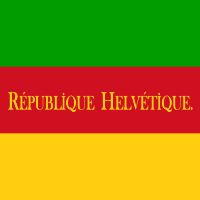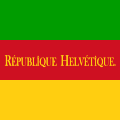Swiss flag
The flag of Switzerland consists of a square red field with an equilateral white Greek cross in the center of the flag. It is one of only two square flags of sovereign states, the other being the flag of Vatican City.
The flag of the Swiss Confederation was probably inspired by the insignia of the Canton of Schwyz, which received a silver cross in commemoration of its fight alongside the troops of the Holy Roman Empire. The old Confederates already used the Swiss cross as a badge on the battlefields. The oldest data dates back to the Battle of Laupen in 1339. At first, the arms of the cross were narrow and long, reaching the edge of the cloth, as in Scandinavian countries.
Other historical flags
The flag presented below was used during the period from 1798 to 1803, during which time the country was invaded by Napoleonic forces and converted into a republic by them. The change of flag to the current one was due to the change of regime. After the defeat of Napoleon's forces, the Congress of Vienna recognized the universal neutrality of Switzerland, in addition to defining the borders of its territory. This allowed Switzerland to organize itself again, to change its configuration, its symbols and to go from a unitary state to a confederation.
Red Cross
The Red Cross flag was also inspired by that of Switzerland, only with the colors reversed, in honor of the homeland of Henri Dunant, its founder.
Image gallery
The rectangular version of the Swiss flag has been used by the country's Olympic team since the 2004 Athens Olympics, following the International Olympic Committee (IOC) rule that all countries use the same format for their national emblems.
Contenido relacionado
Indonesian culture
28th century BC c.
International Civil Aviation Organization

![Pabellón nacional de Suiza.[nota 1]](https://upload.wikimedia.org/wikipedia/commons/thumb/9/92/Civil_Ensign_of_Switzerland_%28Pantone%29.svg/120px-Civil_Ensign_of_Switzerland_%28Pantone%29.svg.png)

